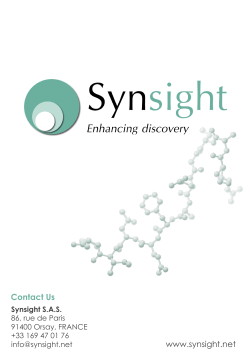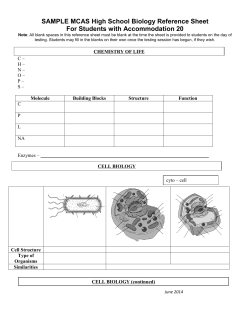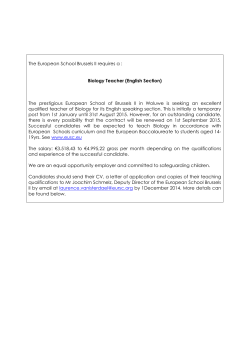
TITLE OF PAPER
Strategies for Teaching Molecular Biology at Grammar School Level: from Theory to Laboratory Practice 1 Martin Jáč1, Vanda Janštová2, 3 2 Department of Biology, Faculty of Education, Palacký University Olomouc, Biology & Environmental Studies Department, Faculty of Education, Charles University, Department of Education and Didactics of Biology, Faculty of Science, Charles University (Czech Republic) 1 2 martin.jac@upol.cz, vanda.janstova@natur.cuni.cz Abstract Molecular biology is one of the most dynamic fields of contemporary biology and plays an important role in biology education at different school levels. Based on our in-depth comparative analysis of 160 Grammar School Education Programmes (42 % of all Czech grammar schools), molecular biology together with genetics and cell biology form an integral part of the grammar school curriculum in the Czech Republic. However, the educational content of molecular biology at grammar school level, including both the subject matter and expected student outcomes, is mostly limited to theoretical concepts, without implementing laboratory experiments, bioinformatics tasks or other laboratory practice-oriented classroom activities. In this paper, we would like to present different strategies and classroom activities for teaching molecular biology at grammar school level. We will focus on various laboratory exercises (e.g. chromosome staining in mitotic cells, different DNA extraction techniques, restriction analysis of DNA, agarose gel electrophoresis), simple bioinformatics tasks (e.g. search within genetic sequence databases, analysis of DNA and protein sequences, 3-D visualization of virus particles or protein structure, construction of phylogenetic trees) or use of virtual laboratories. Another teaching approach we will present is the critical discussion of simple scientific papers and non-fiction articles in the classroom in order to reduce the gap between the educational content and the current state of scientific knowledge in the field of molecular biology. All presented teaching strategies were repeatedly used and verified in the instruction during a 10 years period (2003 to 2013) at the František Palacký Grammar School in Valašské Meziříčí (Czech Republic) with students in grades 11-12 (altogether 145 students, subject “Molecular Biology Seminar”). To assess the effectiveness of the laboratory exercises, we conducted a brief questionnaire survey during years 2011 and 2012. The questionnaire consisted of open-ended questions and five-point Likert-type scale items (ranging from 1 = strongly agree to 5 = strongly disagree), in total we analysed 46 questionnaires. The data among others indicate, that students considered laboratory exercises focused on topics from molecular biology attractive and stimulating (mean value 1.54 on a Likert-type scale), fully understood the theoretical background of the exercise (mean value 1.07 on a Likert-type scale) and were easily able to follow the steps of the laboratory protocol (mean value 1.37 on a Likert-type scale). Therefore, laboratory exercises in molecular biology should be implemented in the instruction to support theoretical concepts and enhance students’ motivation. 1. Introduction Since the discovery of the DNA structure in 1953 by Watson and Crick [1], molecular biology has been implemented in virtually every field of contemporary biology [2]. Moreover, social and ethical issues associated with different aspects of molecular biology (e.g. cloning, genetically modified organisms, molecular diagnostics, gene therapy and many others) are closely affecting our everyday lives [3]. It is therefore no surprise, that molecular biology is one of the core concepts of biology education at different school levels [4, 5, 6]. In this paper, we would like to focus on the current state of molecular biology instruction at grammar school level in the Czech Republic and present our experience with different strategies for molecular biology teaching in the classroom. The compulsory educational content of biology in Czech grammar schools, including both subject matter and expected student outcomes, is defined in the Framework Education Programme for Secondary General Education (FEP SGE) [7]. Based on the FEP SGE, the School Education Programme (SEP) is created by each grammar school. In our previous study, we made an in-depth comparative analysis of 160 SEPs (42 % of all Czech Grammar schools) [8]. The results indicate, that molecular biology together with genetics and cell biology form an integral part of SEPs, but most of the molecular biology topics are frequently included in a single year (usually the last year of compulsory biology instruction). Moreover, the subject matter and expected student outcomes are mostly limited to theoretical concepts without implementing laboratory exercises and other practical teaching activities. We also identified, that 19 SEPs from the analysed sample contained an optional subject of instruction focused in detail on molecular biology. This optional subject was mostly intended for students in grades 11-12 [8]. 2. Strategies for teaching molecular biology at grammar school level Molecular biology and genetics topics are very often abstract and hard to imagine for students, which results in limited understanding of the basic principles of inheritance [9]. It is therefore crucial to use different teaching strategies in the classroom that enable students to visualize and better understand key processes at a molecular level. We would like to present and discuss three approaches that include critical discussion of non-fiction articles and scientific papers, use of simple bioinformatics tasks and implementation of various laboratory exercises into instruction of molecular biology. All presented teaching strategies were repeatedly tested and verified in the biology instruction during a 10 years period (2003 to 2013) at the František Palacký Grammar School in Valašské Meziříčí (Czech Republic). To promote molecular biology instruction, optional subject of instruction called “Molecular Biology Seminar” was established in the school year 2005-2006 for students in grade 12. Altogether, 145 students attended the seminar so far, ranging from 8 to 26 students in different school years. 2.1 Journal Club – critical discussion of scientific papers in the classroom In order to reduce the gap between the educational content of molecular biology in textbooks and the current state of scientific knowledge in the field, we implemented regular lessons focused mainly on critical discussion of non-fiction and scientific articles. We call this teaching strategy the Journal Club. The major educational aim of the Journal Club was the development of critical reading skills and basic scientific literacy in molecular biology among grammar school students. We carefully selected 15 articles from different biology and science journals (e.g. Vesmír, Živa, Scientific American – Czech Edition, Nature and Science). These articles covered main topics of molecular biology including gene expression and its regulation, basic methods of molecular biology, biotechnology (cloning, genetically modified organisms, gene therapy) or genomics. Some of the articles were also focused on the history of molecular biology and principal discoveries in the field (e.g. famous paper by Watson and Crick in Nature describing the structure of DNA – see reference 1). We prepared worksheets for students with several questions (usually up to 10 questions) about the content of each article to facilitate reading and comprehension of the text, because the results of current research show that mere reading of primary literature by students resulted in superficial understanding of the article content [10]. 2.2 Bioinformatics tasks – inquiry-based analysis of the biological data Because of rapid progress in DNA sequencing technology, a tremendous amount of biological data is produced every day and bioinformatics is nowadays an essential part of biology. Although bioinformatics was successfully implemented into the undergraduate curriculum, there is a need to raise the profile in secondary education [11, 12]. For this reason, we introduced simple bioinformatics tasks into our lessons of molecular biology using recommendations described in literature [13]. Lessons focused on bioinformatics tasks were performed in the computer classroom equipped with interactive whiteboard, which made it possible to clearly demonstrate basic bioinformatics tools using interactive presentations before students started to work on their own. The spectrum of implemented bioinformatics tasks and activities included searching within genetic sequence databases, analysis of DNA and protein sequences, computer based 3-D visualization of virus particles and protein structure (see Fig. 1) and construction of phylogenetic trees. Teaching activities were either adopted and modified from educational literature [13, 14, 15] or newly developed by the authors (e.g. analysis of DNA sequences of clock genes governing circadian rhythmicity in different animal species). For teaching purposes, only freely available online databases of biological data (e.g. ENTREZ or RSCB PDB data) and bioinformatics tools and software (e.g. Chromas Lite or UCSF Chimera) were used. All bioinformatics task were conceived as inquiry-based activities (ranging from confirmation to guided inquiry) to support the development of students’ scientific skills. Fig. 1: Computer 3-D visualization of haemoglobin structure. A – deoxyhaemoglobin (all four chains; dark and light magenta = alpha-chains, dark and light blue = beta-chains, yellow = heme molecules); B – oxyhaemoglobin (detail of single alpha-chain where oxygen is bound to iron of the heme molecule; red = heme, yellow = iron atom, blue = oxygen, brown = histidine residue of the alpha-globin chain). This 3-D visualization represents result of bioinformatics activity focused on study of haemoglobin structure and function. Prepared with UCSF Chimera software using PDB entries 2hhb (A) a 1hho (b). 2.3 Laboratory exercises – hands-on activities promoting biology inquiries Laboratory exercises are an essential part of biology instruction. Results of many educational studies demonstrated that laboratory exercises in molecular biology can deepen comprehension of theoretical concepts and shift students’ conceptions to more scientific view [16, 17]. There is a vast amount of protocols for laboratory exercises in molecular biology described in literature, however most of them require expensive laboratory equipment and material that are not usually available in biology classrooms. Simple laboratory experiments that we have easily implemented in the instruction represent DNA extraction from human cheek cells [18] and DNA gel electrophoresis using household materials [19]. We also tested the feasibility of advanced laboratory exercises for grammar school students using a Mobile Laboratory for Molecular Biology and out-of-school laboratory course at the Faculty of Science, Charles University in Prague. Students attending the Molecular Biology Seminar during years 2011 and 2012 conducted three different inquiry-based advanced laboratory exercises: 1) Restriction analysis of bacterial plasmids (performed at the grammar school biology laboratory with equipment from the Mobile Laboratory for Molecular Biology); 2) SDS-PAGE electrophoresis of proteins (performed at the grammar school biology laboratory with equipment from the Mobile Laboratory for Molecular Biology) [20]; 3) PCR detection of human CCR5 genetic polymorphism (out-of-school laboratory course at the Faculty of Science, Charles University in Prague) [21]. To assess the effectiveness of the laboratory exercises, we conducted a brief questionnaire survey at the end of each exercise. The questionnaire consisted of open-ended questions and five-point Likerttype scale items, where 1 = strongly agree, 2 = agree, 3 = neutral, 4 = disagree, 5 = strongly disagree. Students evaluated attractiveness of the exercise, comprehension of the theoretical background of the exercise and understanding of steps of the laboratory protocol. Collected categorical data were subsequently analysed by Kruscal-Wallis test followed by multiple comparisons between the data sets. Altogether, we analysed 46 questionnaires (restriction analysis lab – 15 questionnaires, PCR CCR5 lab – 16 questionnaires and SDS-PAGE electrophoresis lab – 15 questionnaires). The data among others indicate, that students considered laboratory exercises focused on topics from molecular biology attractive and stimulating (mean value 1.54 on a Likert-type scale), fully understood the theoretical background of the exercise (mean value 1.07 on a Likert-type scale) and were easily able to follow the steps of the laboratory protocol (mean value 1.37 on a Likert-type scale). The differences in students’ rating of different aspects of three advanced laboratory exercises on a Likert-type scale were not statistically significant (p > 0.27; see Fig. 2). Fig. 2: Students’ rating of different aspects of three advanced laboratory exercises in molecular biology. Original data were plotted for purposes of graphical representation as follows: 1 = strongly agree, 0.5 = agree, 0 = neutral attitude, -0.5 = disagree, -1 = strongly disagree. Each column represents the whole group mean value. 3. Conclusions In this contribution we introduced three main areas of teaching strategies to promote both theoretical and practical instruction in molecular biology at grammar school level. These include critical discussion of non-fiction and scientific articles in the classroom, use of simple bioinformatics tasks and the implementation of various inquiry-based laboratory exercises. Based on the evaluation of advanced laboratory exercises in our study we can conclude that laboratory exercises in molecular biology should be implemented in the instruction to support theoretical concepts and enhance students’ motivation. Acknowledgements This study was supported by research projects CETPO CZ.1.07/2.3.00/20.0166 (Martin Jáč), IGA_PdF_2014019 (Martin Jáč) and GAUK1168214 (Vanda Janštová). The authors would like to thank to Steven Morris, M.A. for language revision of the manuscript. References [1] Watson, J. D., Crick, F. H. C. (1953). A structure for deoxyribose nucleic acid. Nature 171, 737-738. [2] Nurse, P. (2003). The great ideas of biology. Clinical Medicine 3(6), 560-568. [3] Guttmacher, A. E., Collins, F.S. (2003). Welcome to the genomic era. N. Engl. J. Med. 349 (10), 996-998. [4] National Committee on Science Education Standards and Assessment (1996). National Science Education Standards. Washington, D. C.: National Research Council, National Academy Press. [5] Voet, J. G., Bell, E., Boyer, J., O’Leary, M. O., Zimmermann, J. K. (2003). Recommended curriculum for a program in biochemistry and molecular biology. Biochem. Mol. Bio. Edu. 31 (3), 161-162. [6] Labov, J. B., Reid, A. H., Yamamoto, K. R. (2010). Integrated biology and undergraduate science education: a new biology education for the twenty-first century? CBE – Life Sci. Educ. 9, 10-16. [7] Research Institute of Education in Prague (2007). Framework Education Programme for Secondary General Education (Grammar Schools).100 pp. [8] Janštová, V., Jáč, M. (2015). Instruction of molecular biology at grammar schools: analysis of the current state and potential of its support. Scientia in Educatione - submitted (in Czech). [9] Lewis, J. & Wood-Robinson, C. (2000). Genes, chromosomes, cell division and inheritance - do students see any relationship? Int. J. Sci. Educ. 22 (2), 177-195. [10] Brill, G., Falk, H., Yarden, A. (2004). The learning processes of two high-school biology students when reading primary literature. Int. J. Sci. Educ. 26 (4), 497-512. [11] Lewitter, F., Bourne, P. E. (2011). Teaching bioinformatics at the secondary school level. PLoS Comput. Biol. 7 (10), e1002242. [12] Wood, L., Gebhardt, P. (2013). Bioinformatics goes to school - new avenues for teaching contemporary biology. PLoS Comput. Biol. 9 (6), e1003089. [13] Form, D., Lewitter, D. (2011). Ten simple rules for teaching bioinformatics at the high school level. PLoS Comput. Biol 7(10), e1002243. [14] Ondřej, V., Dvořák, P. (2012). Bioinformatics: A history of evolution „in silico". J. Biol. Educ. 46 (4), 252–259. [15] Pettersen, E., Goddard, T. D., Huang, C., C., Couch, C. S., Greenblatt, D. M., Meng, E. C., Ferrin, T. E. (2004). UCSF Chimera – a visualization system for exploratory research and analysis. J. Comput. Chem. 25, 1605-1612. [16] Franke, G. a Bogner, F. X. (2011). Conceptual change in students’ molecular biology education: tilting at wind mills? J. Educ. Res. 104 (1), 7–18. [17] Scharfenberg, F. J., Bogner, F., X. (2013). Instructional efficiency of tutoring in an outreach gene technology laboratory. Res. Sci. Educ. 43 (3), 1267–1288. [18] Hearn, R. P., Arblaster, K. E. (2010). DNA extraction techniques for use in education. Biochem. Mol. Bio. Edu. 38 (3), 161-166. [19] Ens, S., Olson, A. B., Dudley, C., Ross III, N. D., Siddiqi, A. A., Umoh, K. M., Schneegurt, M. A. (2012). Inexpensive and safe DNA gel electrophoresis using household materials. Biochem. Mol. Bio. Educ. 40 (3), 198-203. [20] Janštová, V., Pavlasová, L. Černý, J. (2014). Inquiry based practical course focused on proteins. In Rusek, M., Stárková, D. (Eds.), Project-based learning in science education. Prague: Faculty of Education, Charles University in Prague, pp. 40-45. [21] Falteisek, L., Černý, J. & Janštová, V. (2013). Simplified technique to evaluate human CCR5 genetic polymorphism. Am. Biol. Teach. 75 (9), 704–707.
© Copyright 2025









